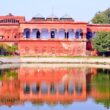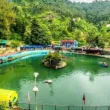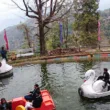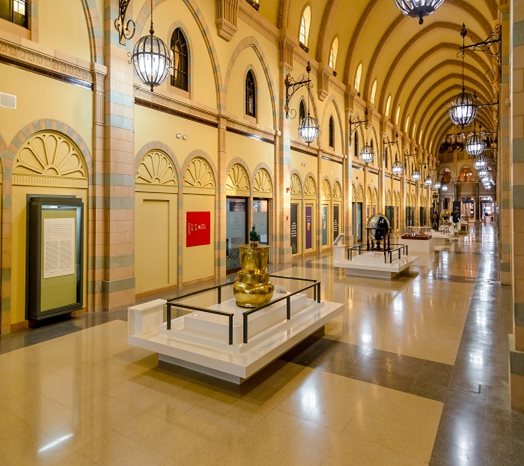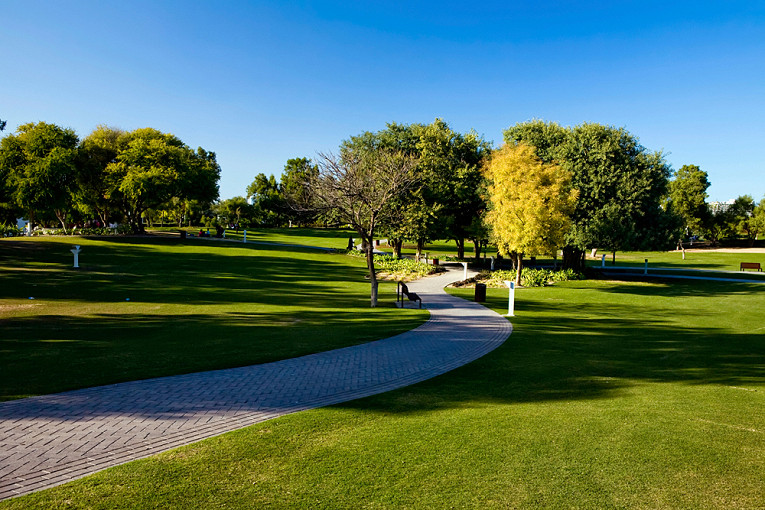Sharjah is the capital of the third-largest Arab emirate of the same name. However, this emirate is famous not for its large size, but for its geographical position: it has access to two ocean bays at once – Persian in the west and Oman in the east. On the one hand, the emirate of Sharjah is bristling with skyscrapers, on the other – it aspires upward with the picturesque Hajar mountains. The city itself, in fact, is a large suburb of Dubai (it’s funny that workers and office managers often rent housing in Sharjah, since it’s cheaper there, and they go to work in the largest city of the UAE) and can be a good option for those who want to avoid Dubai hype and high cost and longs for a beach-family, relaxing holiday.
Places to Visit in Sharjah
Heart of Sharjah Old City

Sharjah the Third-largest Arab Emirate
To see the real Sharjah as it was before the oil era, you need to go to the Old City (Heritage Area). This small “piece of antiquity” is located in the center of the historical part of the city and is surrounded on all sides by modern buildings. Behind the fortress wall surrounding the area around the perimeter, there are compactly restored old houses, several thematic museums, a theater, and a traditional bazaar.
There is an Islamic Museum with an exposition of rare objects of Islamic culture: coins, manuscripts, works of art, ceramic bowls and jugs, candlesticks of the XII-XIV centuries, copper products, and Moroccan daggers. The special “Hall of Sciences” displays a surprisingly accurate ancient map of the world, created 1200 years ago (unlike European maps, the south is located in the upper part here).
Another museum is the Historical Heritage, each room which is dedicated to a certain period of the cultural history of the emirate. The exposition presents samples of local architecture, national clothes, household items, and utensils. It is also interesting to look into the local oriental bazaar. In its shops, you can buy silver and wood products, clothes, spices, tea, coffee, and souvenirs. Don’t forget to bargain!
It is interesting
The old part of the city is adjoined by a quarter of buildings of fifty years ago. Small towers towering over their roofs – badgers – are in fact the “ancestors” of modern air conditioners. The role of the badgers was to catch any breezes and send cool currents down to the living quarters in order to reduce the heat and thus make life easier for people in hot summer.
Near the old quarters is the Sharjah Art Museum, which hosts all of the most significant exhibitions of contemporary and international artists.
Al Mahatta Museum (Sharjah)

Sharjah the Third-largest Arab Emirate
This museum, quite unusual for the Emirates, was once the first airport in the UAE. The British company Imperial Airlines had the idea to use Sharjah as a stopover for its planes on commercial flights from the UK to India. In the 30s, a solid salt platform was rolled out next to the sea for landing and, at the behest of Sheikh Sultan, a fort was built to accommodate cargo and passengers. A little later, the airport became a transshipment base for aircraft flying in transit to Australia.
In 1950 (after the Royal Air Force of Great Britain extended the strip), the fort served as the headquarters of the United Intelligence Forces, patrolling the area between Saudi Arabia and Oman, and in the 60s it also became a base for training and training pilots. In addition, Fort Al Mahatta was the first weather station in the UAE and Oman. From 1934 to 1976, information on weather conditions was collected here.
In 1977, the Sharjah airport “changed its place of residence”, having moved inland, and the weather station, which is still operating, moved with it. The old airport became the Al Mahatta Museum, and its runway became King Abdul Aziz St. There and now you can ride on old slabs, cursing the poor quality of the road and not knowing that you are driving along the former runway. The exposition of the museum – photographs, and models, telling about the glorious past of the airport, you can see a chronicle from the life of those times. There is also an impressive hangar with old propeller-driven aircraft and a tanker, where photography is not prohibited, and many gizmos can be touched.
Sharjah Classic Cars Museum

Sharjah the Third-largest Arab Emirate
The local exposition presents one and a half hundred old cars and motorcycles of the early XX century. The authorities of the emirate were looking for the bulk of the cars around the world, some rarities came to the museum from private collections, including cars from Mercedes, Ford, Citroёn, Packard, and Plymouth. The oldest examples are a 1916 Dodge and a Ford Model T. Among the motorcycles is the Egyptian Ramses, and there is a 1938 Dodge fire engine.
How to get there: the museum is located near Sharjah International Airport, in the Al Badia area on the Sharjah – Dhaid road. A red Cadillac is displayed next to it, which can be seen directly from the highway, so it will not be possible to drive by.
Aljazeera Park (Sharjah)

Sharjah the Third-largest Arab Emirate
It is one of the most popular tourist destinations in Sharjah. Opened in October 1979, the park covers an entire island in Khalid Lagoon. The shady alleys of the park will hide from the city heat and bustle; you can have a picnic on the green manicured lawns. The park has an artificial waterfall and two swimming pools for children and adults. There is also a bowling alley, billiards, video games. Little visitors will be delighted by the town of attractions and a mini-zoo with birds, monkeys, and deer.
In the lagoon, you can swim on a boat, gazing at the fountain that gushes straight out of the water (it is the third-largest of its kind in the world). And also take a ride on the railroad that crosses the entire park. Park scheme.
Sharjah Desert Park

Sharjah the Third-largest Arab Emirate
On a large territory, several unique museums have united into a single park: a natural history museum, a botanical garden, a center for Arabian wildlife, and a children’s farm. The five rooms of the Natural History Museum contain a wealth of material on the flora and fauna of the Arabian Desert. Quite unexpectedly, it turns out that the desert is not at all so deserted, but rather densely populated. Thanks to interactive exhibits, such natural phenomena as volcanic eruptions, meteorite falls, as well as amazing prehistoric landscapes appear before your eyes.
Opened in 2006, the Botanical Museum (together with the garden) tells about everything that grows in the region. The center of the Arabian wildlife contains both fairly typical animals for the region (hyenas and baboons) and rare representatives of the local fauna (Arabian leopard, sand cat, poisonous snakes). At the children’s farm, little ones can get to know the domestic animals of the Emirates (goats, sheep, cows, donkeys), see how they are looked after, and take part in feeding.
The park has a modern research center that breeds endangered animals and plants.
Sharjah Fort (Al Hisn)

Sharjah the Third-largest Arab Emirate
The large majestic fort, built in 1820 by order of the sheik, has long been the residence of the ruling al-Qassimi family, the cultural and business center of the emirate. The imposing walls of the fortress initially served as protection from the raids of hostile Bedouin tribes.
It is a large two-story building of traditional Arab architecture, with three towers, numerous rooms and halls, and a large courtyard. The city museum of Sharjah is located in the fortress, where it is interesting enough to tell about the history of the emirate. It also hosts thematic exhibitions and events.
do not miss
In the residence, the interior of traditional living quarters has been restored, pottery, coffee pots, kitchen utensils, and many other “witnesses” of the former Sharjah are presented. The pride of the museum is a collection of weapons traditional for the Emirates (unique guns, swords made of turtle shells, huge powder reservoirs). One of the halls has been turned into a museum of the ruling Sharjah dynasty, which houses a family library, many old photographs, and jewelry collections.
It is interesting to see the towers of the fort, climb the battlements and look down at the old Sharjah from the observation platforms. Inspection of the fortress will take from half an hour to an hour. Here you can also drink coffee and eat Arabic sweets.
Sharjah Museum of Islamic Civilization

Sharjah the Third-largest Arab Emirate
The Sharjah Museum of Islamic Civilization houses thousands of rare and unique exhibits. Gold-embroidered volumes of the Koran, models of mosques, national oriental costumes, sophisticated Arab jewelry, daggers, and much more. A separate gallery of the museum is dedicated to the development of science and technology. The museum also has prayer rooms.
Abu Bakr Gallery:
This gallery of the Museum of Islamic Civilization serves to acquaint visitors with the origins of the Quran and Islam. Here you will be introduced to the five pillars of the Islamic faith and will also tell you about the Hajj. The gallery contains important documents, photographs, and the historical manuscripts themselves of the main book of Islam.
Ibn al-Haytham Gallery:
This gallery showcases the achievements of Islamic science and the contributions of great Islamic scholars to world civilization. Complex 3D models, audiovisual and extensive information panels tell about some of the most outstanding discoveries, inventions, and theories developed by Islamic scholars in fields such as astronomy, medicine, geography, architecture, mathematics, chemistry, military equipment, sea navigation.
There are other interesting galleries in the Sharjah Museum of Islamic Civilization. In general, this is one of the best places in the world where you can meet and appreciate the contribution made by scientists, religious and artistic figures to the treasury of world science and culture.
Sharjah Art Museum

Sharjah the Third-largest Arab Emirate
Sharjah Art Museum was opened on April 17, 1997. This unique museum offers art lovers the opportunity to admire the splendor of its fine art collection, which is the largest in the Persian region.
Here you can see works of painting, graphics, sculptures by Arab masters. The gem of the museum is the collection of Sheikh Sultan Al Qasimi. The canvases included in it are divided into 8 thematic groups. The most numerous of them are battle pieces. The museum also has an excellent library on the history of fine art: 4 thousand books in Arabic and English are presented here.
The Sharjah Art Museum also houses a rich collection of modern Arab art. For example, paintings by the Palestinian artist Suleiman Mansour, which reflect the situation around the Israeli-Palestinian conflict and the occupied Palestinian territories. You should definitely pay attention to the work of the artist Jamil Hamoudi, one of the pioneers of modern Iraqi art. The gallery also features paintings by Kuwaiti artist Thuraya Al-Baksami and contemporary UAE artists – Abdulkader Al-Rais, Najat Makki, Mohammed Abdullah Bulehia, Mohammed Al-Kassab, and Obeid Sorur.
Sharjah National Park

Sharjah the Third-largest Arab Emirate
This is the largest park in the city. The huge territory of 63 hectares with picturesque lawns and even rows of trees, with benches and barbecue places, is always ready to accept hikers and picnickers. There is also a playground for children with numerous swings and playgrounds, a huge “Giant Slide”, a duck pond, areas for roller skating.
The park has bike paths and bike rentals of various brands and sizes. Part of the paths goes through the “tunnel of fear” with sculptures emerging from the darkness with flashes of light. At times, unsuspecting cyclists are suddenly bombarded with a jet of water – this is the trick of automatic infrared detectors.
do not miss
The main attraction of the park is a miniature model of Sharjah with many buildings and the Khalid lagoon with three islands and bridges. Boats float in the fenced lagoon, and remote-controlled cars drive around the mini-town itself.
The park has an Arabic-style coffee shop with coffee, ice cream, soft drinks (alcohol is not allowed in Sharjah), and snacks.
Al Khan Beach (Sharjah)

Sharjah the Third-largest Arab Emirate
Terribly popular among tourists, the beach can be found near the ancient village of the same name, Al-Khan. The sandy strip stretches to the Al Layyah power plant. On weekends, Sharjah residents come here to swim.
Al Corniche beach

Sharjah the Third-largest Arab Emirate
This long sandy beach surrounded by rows of palm trees is located next to the Coral Beach Hotel. The coast is clean, the waves are safe, although sometimes there are underwater currents, about which guests of the beach are immediately warned with special signs.
Read More About UAE
- Al Ain: The Great Oasis of the UAE
- Sharjah – The Cultural Capital of UAE
- Travel to Doha as soon as possible
- A guide to a normal Dubai holiday
- Dubai Hotels : The 10 Most Luxurious
- Dubai- Tales From The Arabian City
- Dubai – 11 Amazing Must Try Food In 2021
- Abu Dhabi – Perfect place for nature lovers
- Abu Dhabi Places To Visit

